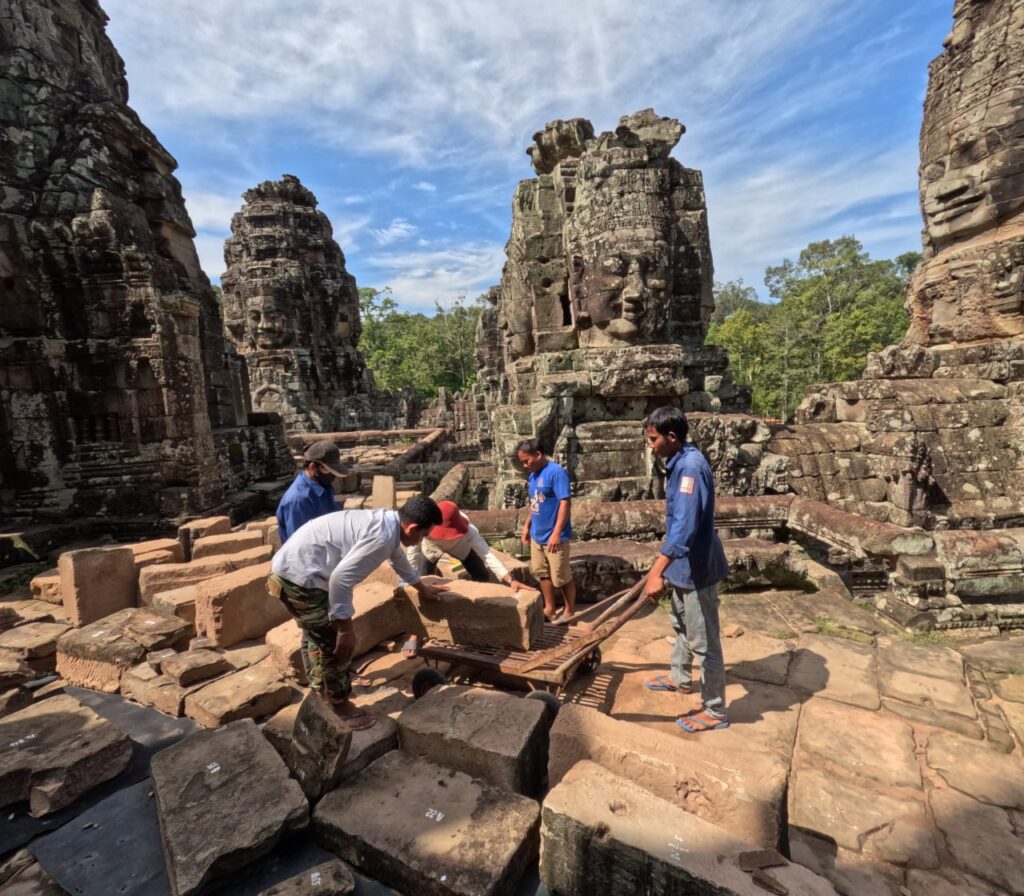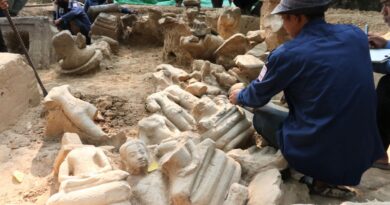ក្រុមអ្នកជំនាញ នៃអាជ្ញាធរជាតិអប្សរាបានកត់សម្គាល់ឃើញថា មានទីតាំងមួយចំនួននៅជុំវិញខឿនរួតទី៣របស់ប្រាសាទបាយ័នឃើញមានល្បាយដីខ្សាច់ហូរច្រោះចេញតាមចន្លោះជញ្ជាំងក្រោយពេលមានភ្លៀង ដែលវាអាចនឹងបង្កជាហានិភ័យដល់ប្រាសាទបុរាណមួយនេះបាន។ ក្រុមស្ថាបត្យករ និងវិស្វកររកំពុងតែធ្វើការសិក្សា និងស្វែងរកវិធីសាស្រ្តដើម្បីទប់ស្កាត់ការហូរច្រោះនៃល្បាយដីខ្សាច់ ព្រមទាំងធ្វើការពង្រឹងរចនាសម្ពន្ធខឿនដែលមានហានិភ័យនោះឡើងវិញ។
ស្ថាបត្យករ និងជាក្រុមការងារបច្ចេកទេសជួសជុលខឿនរួតទី៣របស់ប្រាសាទបាយ័ន កញ្ញា ម៉េង សុវណ្ណលីលីន មានប្រសាសន៍ថា កាលពីចុងឆ្នាំ២០២១ក្រុមការងារធ្លាប់បានសម្អាតកំណកដីនៅតាមប្រព័ន្ធបង្ហូរទឹកជុំវិញរួតទី៣ប្រាសាទបាយ័នម្តងរួចហើយ ប៉ុន្តែមួយឆ្នាំក្រោយមក យើងនៅឃើញមានល្បាយដីខ្សាច់នៅតែបន្តហូរច្រោះចេញមកតាមជញ្ជាំងខឿនរួតទី៣នៃប្រាសាទបាយ័នដដែល ដែលវាជាមូលហេតុចម្បងនាំឱ្យមានការពង្រឹងខឿនជ្រុងនិរតីនៃរួតទី៣នេះឡើងវិញ។
កញ្ញា ម៉េង សុវណ្ណលីលីន បន្តទៀតថា ក្រុមអ្នកជំនាញនៃអាជ្ញាធរជាតិអប្សរាបានសិក្សាស្រាវជ្រាវដើម្បីរកឱ្យឃើញថា មូលហេតុអ្វីដែលបណ្ដាលឱ្យដីខ្សាច់ហូរច្រោះបែបនេះ?។ ក្នុងនោះមានមូលហេតុសំខាន់ៗមួយចំនួនដូចជា ទី១.បញ្ហាឬសឈើកាលពីអតីតកាលបានដុះចាក់ចូលទៅក្នុងរចនាសម្ពន្ធធ្វើឱ្យថ្មមួយចំនួនរំកិលចេញពីទីតាំងដើម និងបង្កើតបានជាប្រហោងនៅតាមចន្លោះថ្ម។ ទី២.បញ្ហាទឹកហូរច្រោះចូលទៅតាមប្រហោងថ្មដែលអាចនាំល្បាយដីខ្សាច់ចេញមកក្រៅបាន ទី៣.បាយអស៊ីម៉ងត៍ដែលបានបំពេញនៅតាមចន្លោះថ្មកម្រាលដោយអ្នកអភិរក្សជនជាតិបារាំងដល់បច្ចុប្បន្នអស់គុណភាពដែលធ្វើឱ្យបរិមាណទឹកភ្លៀងហូរចូលទៅខាងក្នុងខឿនច្រើនលើសកម្រឹត និងទី៤.ដីគ្រឹះខាងក្នុងជាប្រភេទដីខ្សាច់សុទ្ធនិងមានគ្រាប់រាងធំ កាលណាខ្សាច់មានគ្រាប់ធំពុំមានគ្រាប់ទំហំតូច គឺវាមិនសូវមានភាពស្អិតល្អទេពេលមានភ្លៀងម្តងៗទឹកងាយនឹងហូរនាំល្បាយដីខ្សាច់ចេញទៅតាមប្រហោងថ្ម។ កិច្ចការនេះ បានចាប់ផ្ដើមតាំងពីចុងឆ្នាំ២០២២មក ដោយធ្វើការរើថ្មដែលក្រៀកចេញរួចរៀបចូលទីតាំងវិញ និងការយកសំណាកដីផ្នែកខាងក្នុងខឿនទៅធ្វើការវិភាគដើម្បីឱ្យដឹងថា តើស្រទាប់ដីជម្រៅណាមានសភាពខ្សោយដែលត្រូវពង្រឹងឡើងវិញ?។
ជាច្រើនខែមកនេះ ក្រុមអ្នកជំនាញបានរើថ្មបង្កាន់ដៃនាគ ថ្មកម្រាល និងជញ្ជាំងខឿនមួយផ្នែកដែលក្រៀកចេញ ដើម្បីពិនិត្យមើលស្ថានភាពជញ្ជាំងថ្មបាយក្រៀមដោយរើ និងរៀបថ្មភក់ ថ្មបាយក្រៀមដែលមួយផ្នែកឡើងវិញ រួចបិទបាយអនៅតាមចន្លោះថ្មដើម្បីការពារដីខាងក្នុងកុំឱ្យហូរចេញទៀត។ មកដល់បច្ចុប្បន្នជាផែនការបន្តក្រុមអ្នកជំនាញកំពុងត្រៀមធ្វើការបុកបង្ហាប់ដីខាងក្នុងឡើងវិញ រួចរៀបថ្មដែលបានរើចូលទីតាំងទៅតាមរចនាសម្ពន្ធវិញ និងការងារបិទបាយអនៅតាមចន្លោះថ្មកម្រាលដើម្បីកាត់បន្ថយបរិមាណទឹកភ្លៀងហូរចូលទៅក្នុងគ្រឹះ៕
អត្ថបទ៖ ឆាយ ផាន់នី
រូបភាព៖ យី សុថា/ ភោគ ជា
The restoration team to strengthen the structure of the southwest corner platform and prevent the flow of sand from inside the foundation of the third terrace of the Bayon temple
The restoration team from the APSARA National Authority has noticed that some locations around the third terrace of the Bayon temple have seen sand leaking between the walls after the rain, which could pose a risk to an ancient structure. The restoration team is studying and finding ways to prevent sand leaks and strengthen the risky structure.
Ms. Meng Sovanlylin, an architect and technical team, said that at the end of 2021, the team had already cleared the drainage system around the third terrace, but a year later we can still see the sand mixture still seeping out through the wall of the third terrace of the Bayon temple, which is the main reason for the reinforcement of the southwest corner platform.
Ms. Meng Sovanlylin continued that the experts of the APSARA National Authority have studied to find out what caused the sand leaks. There are some important reasons, such as the first problem: the roots of the tree in the past have grown into the structure, causing some stones to move from the original location and creating holes in the stones. Second, the problem of water flowing into the stone holes can bring out the sand mixture. Third, the poor quality of cement mortar filled in between the paving stones by the French conservationists led to excessive rainfall into the platform, and 4. The inner soil is sand and has large grains, so it is not very sticky. When it rains, the water could flow out of the sand mixture easily through the stone holes. This work began in late 2022, with the removal of eroded stones, replacement, and sampling of the inner soil to analyze which shallow soils need to be strengthened.
Over the months, the restoration team has been removing the Naga balustrade stones, floor stones, and partially cracked stones to check the condition of the laterite walls by relocating and re-arranging the laterite sandstone and filling the mortar between the stones to prevent the soil inside from leaking out. Until now, as a plan to continue, experts are preparing to compact the soil inside and re-arrange the stones that have moved into the structure, and work on filling the mortar between the stones to reduce the amount of rainfall flow into the foundation.
Article: Chhay Phanny
Photos: Yi Sotha / Phouk Chea





